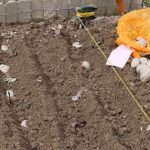Are you looking to optimize your vegetable garden and maximize space? Raised bed gardening offers numerous benefits and allows for more efficient use of space. In this article, we will explore the advantages of raised bed gardening and the crucial role that proper spacing plays in growing healthy and productive vegetables.
Raised bed gardens are a popular choice for many home gardeners due to their ability to improve soil quality, drainage, and temperature control. Additionally, they can be ideal for those with limited outdoor space or poor soil conditions. Proper spacing is essential in a raised bed garden to ensure that vegetables have enough room to grow and thrive without competing for resources.
In the following sections, we will delve into the various types of raised bed structures available, including different materials and styles. We will also provide tips for selecting the best vegetables for raised bed gardening and offer guidance on planning your layout to maximize efficiency. Detailed information on recommended spacing for different vegetables will be provided, as well as tips for proper planting techniques to maintain adequate spacing as your plants grow.
We will also discuss companion planting and how it can aid in both spacing and pest control. Finally, we will address ongoing maintenance and care, as well as the ultimate reward of a successful harvest from your raised bed garden. Whether you are new to gardening or looking to improve your current setup, this article aims to provide valuable insights into achieving optimal results through raised bed gardening with proper spacing techniques.
Types of Raised Bed Structures
There are various materials and styles available for creating raised bed gardens, each with its own advantages and disadvantages. Some of the most common types of raised bed structures include wooden frames, metal or plastic garden beds, cinder block or stone walls, and even recycled materials such as old tires or pallets. Each type has its own unique benefits in terms of durability, aesthetics, and cost.
Wooden Frames
Wooden frames are a popular choice for raised bed gardening due to their versatility and natural look. They can be easily customized to fit any size or shape, making them ideal for small or uniquely shaped spaces. However, wood may rot over time and will need to be regularly replaced or treated with a protective sealant.
Metal or Plastic Garden Beds
Metal or plastic garden beds offer excellent durability and resistance to weathering. They are also lightweight and easy to assemble, making them a convenient option for gardeners looking for low-maintenance raised bed structures. However, these materials may not blend as seamlessly into the landscape as wooden frames.
Cinder Block or Stone Walls
Cinder block or stone walls provide a sturdy and long-lasting structure for raised bed gardens. They can withstand the elements well and add a rustic charm to the garden. However, they can be challenging to assemble due to their weight and may require more effort in terms of construction.
Regardless of the type of raised bed structure you choose, it is important to consider factors such as cost, maintenance needs, and aesthetic appeal when selecting the right material for your garden. The chosen material will impact not only the look of your garden but also its longevity and how well it retains soil moisture for your vegetables.
Selecting the Right Vegetables
When it comes to raised bed gardening, selecting the right vegetables is essential for a successful and productive garden. One of the key factors to consider when choosing vegetables for raised bed gardening is their size and growth habits.
Since raised beds are typically smaller than traditional gardens, it’s important to select vegetables that are well-suited for this type of environment. Look for compact or dwarf varieties of vegetables that won’t overwhelm the limited space in a raised bed.
Another consideration when selecting vegetables for raised bed gardening is their overall productivity and harvest yield. Choose vegetables that are known to produce high yields in small spaces, such as cherry tomatoes, bush beans, and leafy greens like lettuce and spinach. These types of vegetables are not only space-efficient but also provide a bountiful harvest throughout the growing season.
Additionally, consider the specific needs of the vegetables you choose in terms of sunlight, water, and soil condition. Some vegetables may require full sun, while others can thrive in partial shade. Understanding the requirements of each vegetable will enable you to plan your layout effectively and ensure that each plant has the proper conditions for optimal growth. By carefully selecting the right vegetables for your raised bed garden, you can set yourself up for a successful and abundant harvest.
Finally, when choosing vegetables for raised bed gardening, consider plants that work well with vertical supports or trellises. Growing vining or climbing vegetables such as cucumbers, pole beans, or peas allows you to maximize space by training them to grow upwards rather than spreading out horizontally.
This approach further optimizes spacing in your raised bed garden and increases the overall productivity of your garden. With these tips in mind, you can make informed decisions about which vegetables to include in your raised bed garden for a flourishing and rewarding growing experience.
Planning Your Layout
When it comes to raised bed gardening, proper planning and layout design are essential for maximizing space and efficiency. A well-designed raised bed garden can ensure that you make the most of the available space while allowing for proper spacing between vegetables. Here are some key considerations for planning your layout:
Utilizing Vertical Space
One of the advantages of raised bed gardening is the ability to utilize vertical space. Consider incorporating trellises or other vertical structures to support vining vegetables such as tomatoes, cucumbers, and beans. By growing these vegetables vertically, you can save valuable ground space for other crops and ensure optimal spacing between plants.
Square Foot Gardening
The square foot gardening method is a popular approach for planning the layout of a raised bed garden. By dividing the bed into square-foot sections and following specific planting guidelines for each square, you can maximize efficiency and spacing. This method allows you to plant a wide variety of vegetables in a compact space while ensuring that each plant has adequate room to grow.
Companion Planting
Another aspect to consider when planning your raised bed garden layout is companion planting. This technique involves planting certain vegetables together to maximize space and provide natural pest control and mutual benefits. For example, pairing tall-growing plants with shorter ones can create shade and improve spacing, while also deterring pests in a natural way.
Properly designing and mapping out your raised bed garden can lead to an abundant harvest while ensuring that vegetables have sufficient space to thrive. By considering vertical space, utilizing square foot gardening methods, and incorporating companion planting techniques, you can create a productive and efficient raised bed garden that makes the most of available space while maintaining proper spacing between vegetables.
Spacing Guidelines
When it comes to raised bed gardening, proper spacing for vegetables is crucial for ensuring healthy growth and maximum yield. By following recommended spacing guidelines, you can optimize the use of your raised bed garden space and promote better airflow and sunlight exposure for your plants. Here are some detailed spacing recommendations for various vegetables in a raised bed garden:
- Tomatoes: For determinate varieties, plant them 18-24 inches apart; indeterminate varieties should be spaced 24-36 inches apart
- Carrots: Space carrot seeds or seedlings 2-3 inches apart, with rows spaced at least 12 inches apart
- Lettuce: Plant lettuce seedlings or seeds 8-12 inches apart
- Zucchini: Space zucchini plants 24-36 inches apart in rows spaced at least 36 inches apart
It’s important to note that specific spacing requirements may vary depending on the variety of each vegetable and the size of your raised bed garden. Be sure to refer to the instructions on seed packets or plant tags for individual recommendations.
Incorporating proper spacing not only promotes healthier plant growth but also makes it easier to tend to your garden by providing ample room for watering, weeding, and harvesting. It also helps prevent overcrowding, which can lead to competition for nutrients and increased susceptibility to pests and diseases among the plants. By following these guidelines, you can maximize the productivity of your raised bed garden while maintaining a well-organized and visually appealing layout.
Planting Techniques
Maintaining proper spacing for vegetables in a raised bed garden is crucial for ensuring healthy growth and maximizing yield. When planting in raised beds, it’s important to follow specific guidelines for spacing to avoid overcrowding, which can lead to competition for nutrients and stunted growth. Additionally, proper spacing allows for adequate airflow between plants, reducing the risk of disease.
When planning your raised bed garden layout, consider the mature size of each vegetable plant and allocate the appropriate space accordingly. For example, larger plants such as tomatoes and peppers will require more room between them compared to smaller plants like lettuce and carrots. The goal is to provide enough space for each plant to reach its full potential without encroaching on neighboring plants.
One common mistake in raised bed gardening is underestimating the amount of space certain vegetables need to thrive. It’s essential to research the specific spacing requirements for each type of vegetable you plan to grow in your raised bed garden. Proper spacing not only promotes healthy growth but also makes it easier to manage and maintain your garden throughout the growing season.
| Vegetable | Spacing |
|---|---|
| Tomatoes | 24-36 inches apart |
| Lettuce | 6-12 inches apart |
| Carrots | 2-3 inches apart |
Companion Planting
Here are some key benefits of companion planting in a raised bed garden:
- Pest Control: Certain plants have natural repellent properties that can help deter pests from attacking neighboring vegetables. For example, planting aromatic herbs like basil or rosemary near susceptible vegetables like tomatoes can help ward off pests such as aphids or hornworms.
- Space Optimization: Companion planting allows for efficient use of space within a raised bed garden. By pairing plants that complement each other in terms of growth habits and root structures, gardeners can maximize their yields without sacrificing valuable growing space.
- Nutrient Enhancement: Some plants have the ability to enhance the soil by fixing nitrogen or releasing beneficial compounds that can improve the overall health of neighboring vegetables. For instance, planting legumes like peas or beans alongside heavy feeders like corn or squash can help replenish essential nutrients in the soil.
Incorporating companion planting strategies into your raised bed gardening plan not only aids in maximizing spacing and controlling pests but also promotes a more balanced and sustainable ecosystem within your garden. By carefully selecting which vegetables to grow together, you can create a harmonious environment that supports the health and productivity of your crops.
Maintenance and Care
Once your raised bed garden is planted, it’s important to maintain it properly to ensure the health and productivity of your vegetables. Proper watering is essential for raised bed gardening. The soil in raised beds tends to drain faster than traditional gardens, so you may need to water more frequently, especially during hot and dry weather. It’s important to water at the base of the plants to avoid wetting the foliage, which can lead to diseases.
In addition to watering, fertilizing is also crucial for the success of your raised bed garden. Since the growing space is limited in a raised bed, nutrients can become depleted more quickly. Consider using organic fertilizers or compost to replenish the soil with essential nutrients. Regularly monitor the health of your plants for signs of nutrient deficiencies and adjust your fertilization schedule as needed.
Controlling weeds is another important aspect of maintaining a productive raised bed garden. Keep an eye out for weeds and remove them promptly before they have a chance to take hold and compete with your vegetables for nutrients and water. Mulching can also help suppress weeds while retaining moisture in the soil. With proper maintenance and care, you can ensure that your raised bed garden remains healthy and productive throughout the growing season.
| Aspect | Tips |
|---|---|
| Watering | Water at the base of plants. |
| Fertilizing | Consider using organic fertilizers or compost. |
| Weed Control | Regularly remove weeds and consider using mulch. |
Harvesting and Success
In conclusion, achieving a successful and bountiful harvest from your raised bed garden is greatly influenced by the proper spacing of vegetables. The benefits of raised bed gardening are numerous, from improved soil drainage to better pest control, and ensuring that your vegetables are spaced correctly only adds to these advantages. By following the recommended spacing guidelines for various vegetables in a raised bed garden, you can optimize the use of space and promote healthy growth for each plant.
Furthermore, proper spacing in raised bed gardening allows for better air circulation between plants, reducing the risk of diseases and promoting overall plant health. This also enables easier access for maintenance and harvesting, as well as makes it possible to utilize companion planting techniques for natural pest control and mutual benefit between different species of plants. In essence, achieving success in raised bed gardening ultimately comes down to meticulous planning and adhering to proper spacing guidelines for your chosen vegetables.
Overall, by carefully considering the layout of your raised bed garden, selecting the right vegetables, following spacing guidelines, implementing effective planting techniques, maintaining companion planting practices, and providing consistent maintenance and care, you can ensure a successful harvest. Properly spaced vegetables not only contribute to the aesthetic appeal of your garden but also play a crucial role in maximizing yields and facilitating overall garden management.
With dedication and attention to detail in matters such as raised bed gardening spacing vegetables, you can enjoy a rewarding experience and an abundance of fresh produce from your own backyard.
Frequently Asked Questions
How Far Apart to Plant Vegetables in Raised Beds?
The distance between vegetable plants in raised beds depends on the specific plant’s size and variety. Generally, larger plants like tomatoes or peppers may need 18-24 inches of spacing, while smaller plants like lettuce or radishes may only need 6-12 inches.
What Vegetables Should Be Planted Together in a Raised Bed?
When planning which vegetables to plant together in a raised bed, it’s important to consider their compatibility and growth habits. For example, tall plants like corn or trellised crops like cucumbers can provide shade for shorter plants like lettuce or spinach. Additionally, some plant combinations can deter pests or diseases.
How Many Vegetable Plants in a 4×8 Raised Bed?
The number of vegetable plants that can fit in a 4×8 raised bed varies depending on the specific vegetables being grown and their spacing requirements. For example, if you’re planting larger plants with an 18-inch spacing, you may be able to fit around 32 plants in a 4×8 bed.
However, if you’re planting smaller vegetables with a 6-inch spacing, you could potentially fit over 100 plants in the same bed.

If you’re looking to get into vegetable gardening, or are just looking for some tips on how to make your current garden better, then you’ve come to the right place! My name is Ethel and I have been gardening for years. In this blog, I’m going to share with you some of my best tips on how to create a successful vegetable garden.





